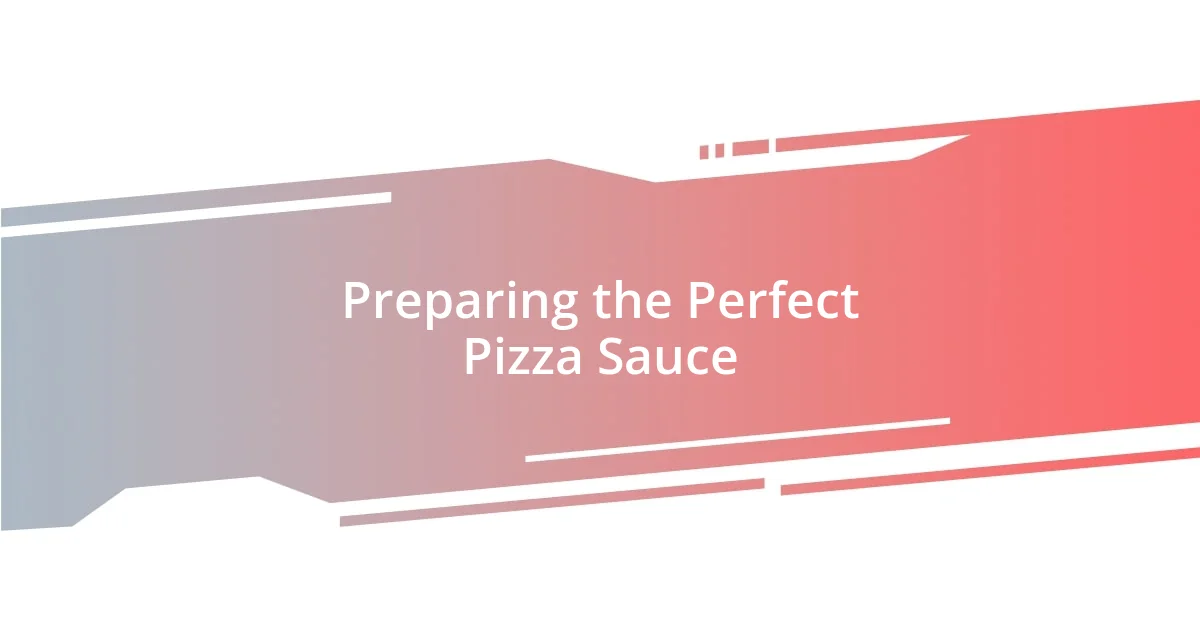Key takeaways:
- Essential tools for home pizza-making include a sturdy pizza stone, a pizza peel for easy handling, and a good quality rolling pin for dough preparation.
- Choosing the right pizza dough involves considering the type of yeast, hydration levels, flour type, and allowing adequate resting time for optimal texture.
- The key to a perfect pizza lies in assembling it thoughtfully with balanced flavors, proper layering of toppings, and using baking techniques that ensure a crispy crust.

Essential Pizza Making Tools
When it comes to making pizza at home, having the right tools can be a game changer. A sturdy pizza stone is essential; it mimics the high heat of a traditional oven and ensures a crispy crust that’ll make you feel like you’re sitting in your favorite pizzeria. The first time I used one, I was amazed at the difference it made—my crust was golden and crunchy, just like I remembered from those late-night takeout runs.
Another must-have is a pizza peel, which might seem trivial, but trust me, it’s not! It allows you to smoothly slide your pizza into the oven without losing a topping or two. I still chuckle at my first attempt without one; I ended up with half my masterpiece on the floor! Using a peel not only makes the process easier but also adds an element of fun; you’ll start to feel like a seasoned pro in your own kitchen.
Lastly, don’t overlook a good quality rolling pin. Rolling out dough can be tricky, and the right pin makes all the difference. I learned this the hard way when my old pin just stuck to the dough, leading to a sticky mess. After upgrading, my dough rolled out evenly every time. It’s these little tools that elevate your pizza-making game, turning cooking into an enjoyable experience rather than a chore.

Choosing the Right Pizza Dough
Choosing the right pizza dough can be the crisp difference between an average night in and a pizza party extravaganza. I’ve experimented with various types, and I always return to a classic yeast dough for that perfect chewy texture. There’s something so satisfying about watching the dough rise, waiting for that moment when you know dinner is going to be fantastic.
When you’re picking your dough, consider these key points:
- Type of Yeast: Active dry yeast is a go-to for home cooks; it gives the dough a delightful kick as it rises.
- Hydration Levels: A higher hydration level (more water) can yield a lighter, airier crust, so don’t shy away from experimenting!
- Flour Type: Bread flour gives a great structure and chew—trust me, I’ve had too many disappointing thin-crust attempts using all-purpose flour.
- Resting Time: Letting your dough rest is crucial. I once rushed this step, and the result was a dense, doughy disappointment.
Remember, the perfection you seek lies in the balance of ingredients and patience. Happy pizza making!

Preparing the Perfect Pizza Sauce
When I first started experimenting with pizza sauce, I never realized how much flavor could come from such simple ingredients. The base of a great pizza sauce usually includes good quality canned tomatoes, garlic, olive oil, and a touch of salt. I remember the first time I made my sauce from scratch; the vibrant, fresh taste totally blew me away compared to store-bought versions. It felt like I discovered a secret weapon in my pizza-making arsenal!
Layering flavors is key in perfecting your sauce. I like to sauté some minced garlic in olive oil before adding the tomatoes to deepen the flavor profile. A pinch of sugar can help balance the acidity of the tomatoes, and let’s not forget about the herbs! Dried oregano and basil can take your sauce to the next level. I once forgot the sugar one time—and wow, it was a noticeable difference. Now, I make sure to keep that balance just right.
Lastly, don’t skip the simmering process. Letting your sauce cook slowly allows all the flavors to meld beautifully. I usually let it simmer for about 30 minutes or so, stirring occasionally, and I can’t help but take a little taste as it thickens. The moment I tasted my sauce that first time, I was hooked; I knew I’d never reach for a jar again. This sauce is what elevates your homemade pizza from ‘good’ to an irresistible masterpiece.
| Ingredient | Notes |
|---|---|
| Tomatoes | Use quality canned San Marzano tomatoes for best results. |
| Garlic | Fresh minced garlic should be sautéed for deeper flavor. |
| Olive Oil | High-quality extra virgin olive oil enhances richness. |
| Salt and Sugar | Balancing acidity with sugar and seasoning with salt is essential. |
| Herbs | Dried oregano and basil elevate the flavor; fresh can be added later. |
| Simmering | Cooking slowly helps meld flavors; aim for at least 30 minutes. |

Selecting Toppings for Flavor
Selecting toppings for pizza is where the fun really begins, and oh, the choices can be overwhelming! When I first started making pizzas at home, I tended to stick to traditional toppings—pepperoni and mozzarella, you know. But then I ventured into the world of gourmet toppings, and it opened up a whole new level of flavor and creativity. Ever tried figs and prosciutto? It’s like a sweet and savory dance on your taste buds!
I’ve learned that the secret to a delicious pizza lies in choosing toppings that not only taste great together but also complement each other in texture. For instance, pairing creamy ricotta with crunchy arugula adds an exciting contrast. One time, I went all-in with fresh peaches, goat cheese, and a drizzle of balsamic glaze—let’s just say my friends were blown away. Those surprising combinations can create memorable experiences, so don’t hesitate to experiment!
Also, consider the balance of flavors. You might want a spicy kick from jalapeños, but it’s essential to counter that heat with something cooling, like a dollop of sour cream or a sprinkle of cilantro, to keep things well-rounded. I’ve had pizzas where overdoing the spicy toppings left my palate begging for mercy. So, the next time you’re selecting toppings, think about how each one plays a role in the overall flavor symphony you’re creating!

Assembling Your Pizza Properly
Assembling your pizza properly is where the magic really happens. I always start with the dough; it’s the foundation of your masterpiece. When I was a novice, I sometimes overwhelmed my crust with sauce or too many toppings. I’ve learned the hard way—less is often more! I like to use just a thin layer of sauce, followed by a sprinkle of cheese that’s evenly distributed. This helps ensure that every bite is flavorful, and my friends can grab a slice without everything sliding off.
Next comes the toppings, and this is where I let my creativity roam free. I vividly remember a pizza night with friends when I decided to go for a wild combination: caramelized onions, goat cheese, and fresh thyme. The aromas in my kitchen were heavenly! Layering toppings thoughtfully is crucial, so I place heavier ingredients like meat under the cheese, while delicate ingredients like fresh herbs go on top. This keeps them vibrant and flavorful, rather than wilting under the heat.
Don’t forget about the baking process – it’s just as vital as how you assemble it! Preheating my pizza stone has become a ritual for me, and honestly, it makes a world of difference. I often feel that anticipation as I slide my assembled pizza into the oven, and I can’t help but peek through the oven door, watching that crust turn golden brown. That little moment of suspense before taking it out? Pure joy! So, remember, a well-assembled pizza not only looks inviting but also promises that delightful crunch and melty goodness that we all crave.

Baking Techniques for Crispy Crust
Achieving a crispy crust is a science and an art, and my experiences have taught me a few key techniques. One method I swear by is using a preheated cast iron skillet. The first time I did this, I felt like a culinary genius when that sizzling sound greeted me as I placed the dough in the hot pan. It’s a game-changer! The intense heat not only seals the bottom but also gives it that irresistible crunch that can rival any takeaway place.
Timing is another crucial factor in baking. I’ve had nights where I could hardly wait and pulled my pizza out too soon, only to end up with a disappointing chewy mess. It taught me to be patient—and to use a timer! I now check my pizza a couple of minutes before the recommended baking time, allowing myself to gauge that perfect golden hue. Have you ever felt the joy of pulling a pizza out of the oven and hearing that delightful crack when you slice through? It’s these little victories that keep me coming back for more.
Lastly, consider experimenting with different types of flour. I recently tried making a pizza with bread flour instead of all-purpose, and oh my goodness, the texture was a revelation! It had an elasticity that made for the chewiest bite while still maintaining that crisp exterior. I’ve learned that each type of flour brings its own personality to the crust, and discovering that has really opened up my pizza-making journey. Which types have you tried, and which are next on your list?

Serving and Enjoying Your Pizza
After pulling my pizza out of the oven, the excitement hits me like a wave. I can’t resist the joy of slicing it up and admiring that crispy crust and bubbling cheese. I always serve my pizza on a wooden cutting board, which adds a rustic charm. It reminds me of cozy evenings spent with loved ones, when laughter and good food blend seamlessly. Have you ever noticed how sharing a pizza can make even the simplest gathering feel special? It transforms the moment into something memorable.
When it’s time to dig in, I encourage a little fun between bites. Depending on my mood, I might offer a selection of dips like tangy marinara or a zesty pesto. There’s something wonderfully interactive about letting everyone customize their slices, which always sparks delightful conversations. Once, while chatting over a few wedges of my homemade creation, a friend playfully dared me to try pineapple on pizza. It turned into a heated debate about toppings that I still chuckle about today! Sharing those playful experiences makes the meal all the more enjoyable.
Lastly, I always take a moment to appreciate the colors and aromas before indulging. The vibrant greens of fresh basil or the enticing drizzle of olive oil can be as appealing as the taste itself. When I finally take that first bite, I let the flavors dance on my palate—it’s a blend of comfort and satisfaction. Have you ever paused to truly savor your first slice? That thoughtful moment elevates the experience from merely eating to genuinely enjoying my creation.















